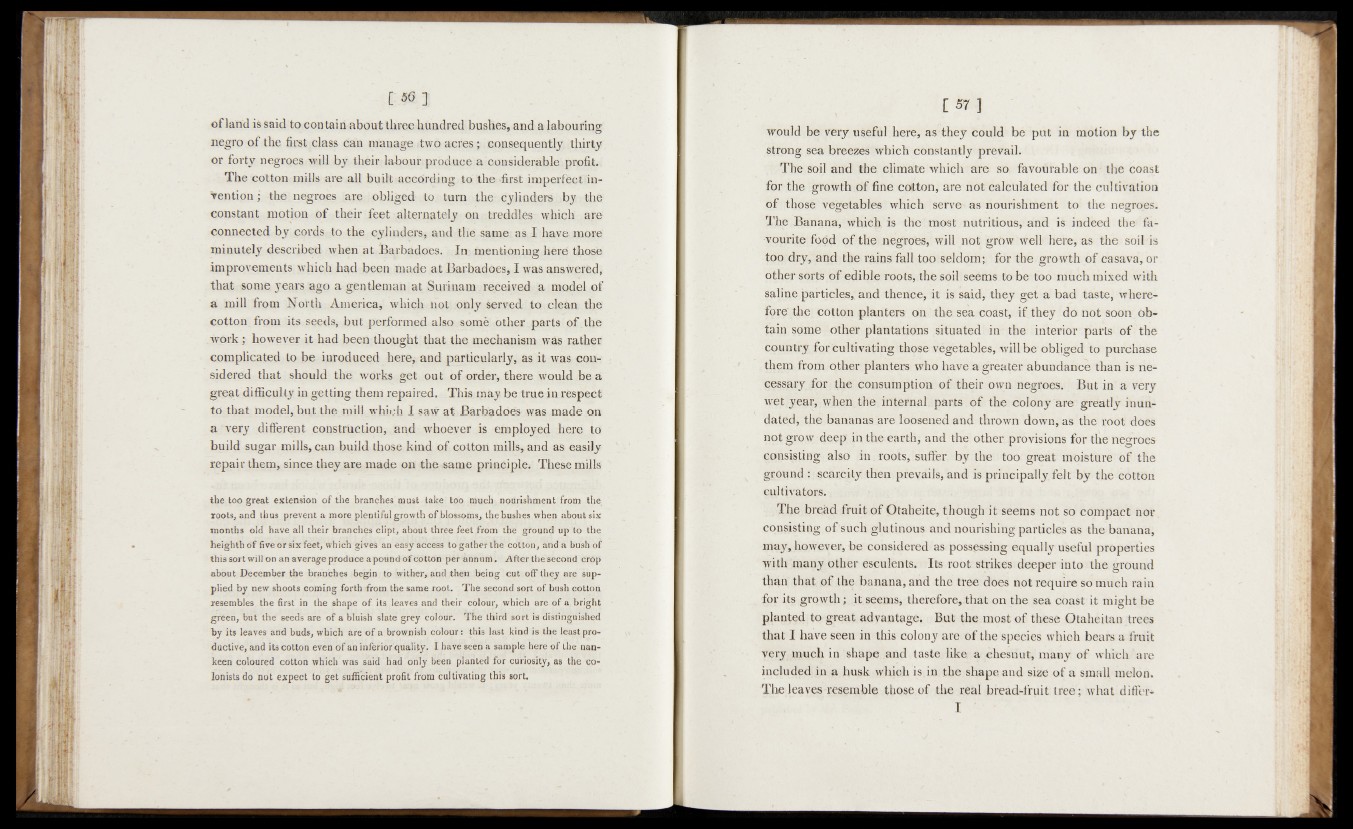
of land is said to contain about three hundred bushes, and a labouring
negro of the first class can manage .two acres ; consequently, ■thirty
or forty negroes will by their labour produce a considerable profit.
The cotton mills are all built aOGdrdjng to: th e .first imperfeefiin-
Vention; the negroes are obliged to turn the.cylinders ^byn thd
constant motion of their feet alternately on fcreddl.es which are
connected by cords to the cylinders, and; the same.; as X hayetnore
minutely described when at Barbadoes. In mentioning herd tfiose
improvements which had been made at Barbadoes, I was answered;
that some years ago a gentleman at Surinam .received a model of
a mill from North America, which not; only served to clean the
cotton, frpm its seeds, but performed also some other parts of the
work; however it had been thought that the mechanism was rather
complicated to be iuroduced here, and particularly, as it was considered
that should the works get out of order, there would be a
great difficulty ingetting them repaired. This tnay be true in respect!
to that model, but the mill which 1 saw at Barbadoes was made on
a very different construction, and whoever is employed ;here to
build sugar mills, can build those kind of, cotton mills, and as easily
repair them, since they are made on the-same principles Tltfsemilla
the too great extension of the branches must take too much, nourishment from the.
roots, and thus prevent a more plentiful growth o f blossoms, the bushes when, about six
months old have all their branches dipt, about three feet,from the ground up to the
heigbthdf five or six feet, which gives an easy access to gather the cofion', and a biishi hf
this sort will on an average produce a pound o f cotton per annum. After the second c'rbp
about December the branches begin tp wither, and then being cut off they are supplied
by new shoots coming forth from the same root. The second sort of,bush cotton
resembles the first in the shape o f its leaves and their colour, which are o f a, bright
green, but the seeds are of a tduish slate grey colour. The third sort is distinguished
by its leaves add bnds, which are o f a: brownish colour: this last kind is the least productive,
and its cotton even o f an inferiorquality. I have seen a sample here o f the nankeen
coloured cotton which was said had only been planted for curiosity, as the colonists
do not expect to get sufficient profit from cultivating this sort.
would be very useful here, as they could be put in motion by the
strong sea breezes which constantly prevail.
■ The soil and the climate which are so, favourable on the coast
for the growth of fine costton, are not calculated for the cultivation
of those vegetables which serve as nourishment to the negroes.
The Banana, whiejt. is the ; most nutritious, and is indeed the favourite
food ofi the negroes, will not grow well- here, as the soil is
too dry, and the rains fall too seldom; for the growth of casava, or
other sorts of edible roots, the soil seems to be too much miked with
saline particles,, and thence, it is said, they get a bad taste, wherefore'the
eotton planters on the sea coast, if they do not soon obtain
some other plantations situated in the interior parts of the
country for cultivating those vegetables, will be obliged to purchase
them from other planters who have a greater abundance than is necessary
for the consumption of their own negroes. But in a very
wet^earj when^ the. internal, parts of the colony are greatly inundated,
th# bananas iare loosened and thrown down; as the root does
not; ^rq;w deep in the earth, and the other provisions for tlie negroes
coms^tiug alsb in . roots, suffer by the too great moisture of the
ground:; scarcity then prevails, and is principally, felt by the cotton
cultivators.,
Tfie bread fruit of Otabeite, though it seems not so compact nor.
cqpfijsting of such glutinous and nourishing particles as the banana,
may,fioweyer, be considered as possessing equally useful properties
with many other esculents. Its root strikes deeper into the ground
than that of the banana, and the tree dees not require so much rain
for its growth; it. seems, therefore,.that on the sea coast it might be
planted to great advantage. But the most of these Otaheitan trees
that I have seen in this colony are of the species which bears a fruit
very much in shape and taste, like a ehesnut, many of which are
included in a husk which is;in the shape and size of a small, melon.
The Jeaves-resemble those of the real bread-fruit tree; what differ*
I